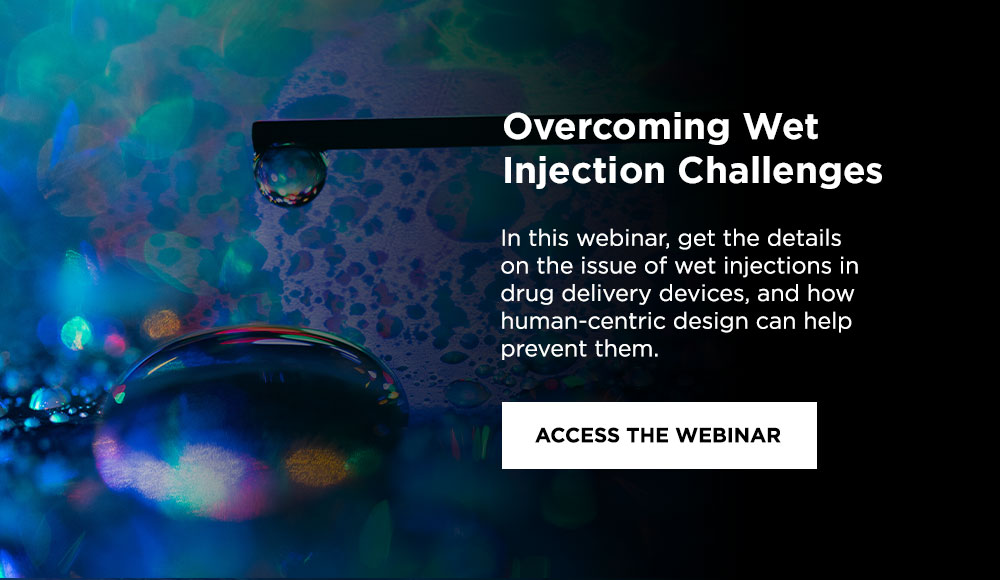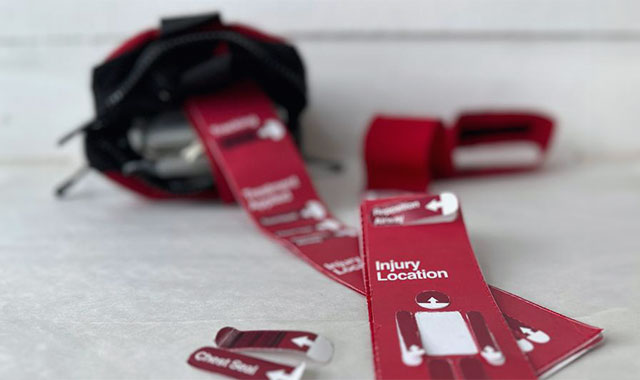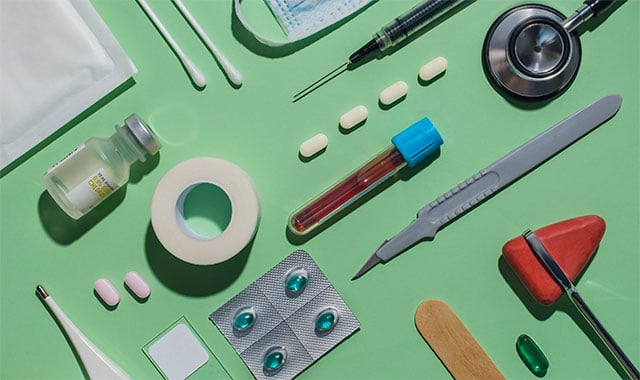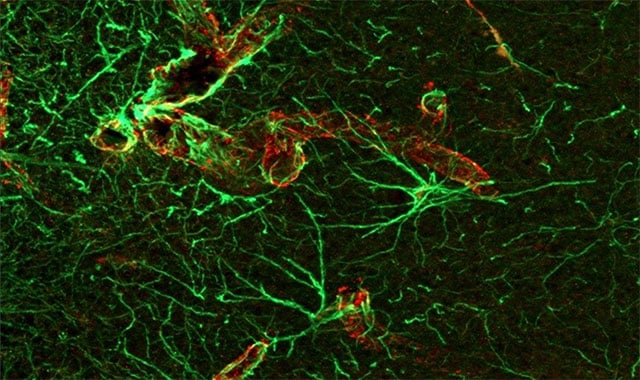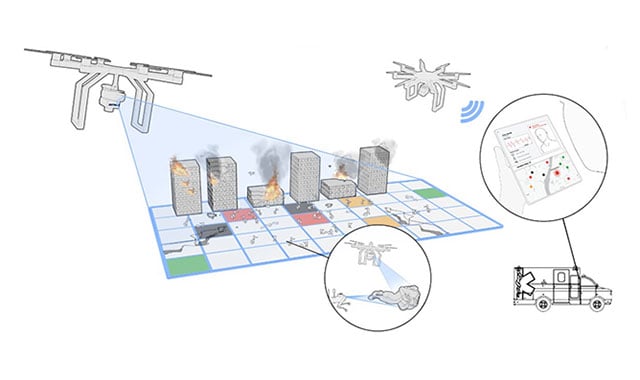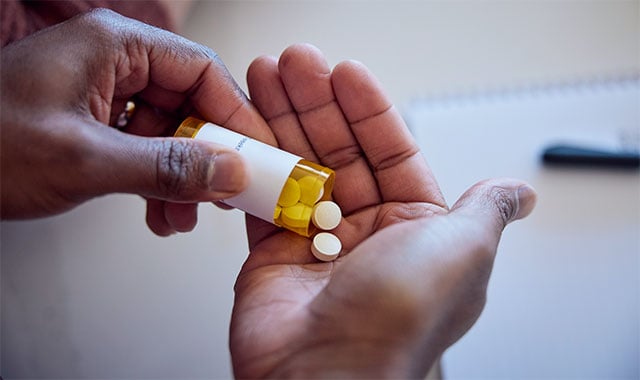Overcoming Wet Injection Challenges with Human Centered Design

All About Wet Injections
In the world of medical devices, a common yet often overlooked issue is that of wet injections. A wet injection is when the injection device is removed from the skin while the medication is still being delivered. This often happens when a user thinks they have completed the injection, but the medication ends up pooled or lost.
There are several scenarios that may cause a user to experience a wet injection. For example:
- Lifting too early, as the user thinks the injection is a far quicker process than expected
- Misinterpreting an audible or visual cue
- Failing to hold the device at the injection site for the correct hold time after the device has been activated or the injection is completed
- Inadvertently activating the device before the needle is inserted into the injection site
- Pressing too hard at the site while injecting, thereby compressing the tissue so the medication cannot be absorbed
Each of these causes presents unique challenges that require specific solutions.

Different types of wet injections
Inexperienced users are most likely to commit use errors, including wet injections. This is often because they are unfamiliar with the device or the medication it delivers.
The increasing prevalence of medications with higher volumes and more viscous biologic medications leads to longer injection times, increasing the likelihood of wet injections.
The issue of wet injections is more significant than it may initially appear. Not only does it result in underdosing, but it can also negatively impact the user experience and the overall product development process.
For instance, users who experience wet injections may become dissatisfied with the device and choose to switch to a different product. From a product development perspective, wet injections can lead to customer complaints and the need for product recalls or redesigns, which can be costly and time-consuming. When these potential outcomes are added to the primary concern of wet injections contributing to reduced therapeutic benefit to a user from not getting any or all of their prescribed dose of medication, a compelling argument is made that solutions are needed to find ways to further mitigate the risk of a wet injection occurring when using an injection device.
Wet Injections and Usability Studies
Our research at Battelle found four types of wet injections to be the most prevalent.
Type 1: Lift and Spray
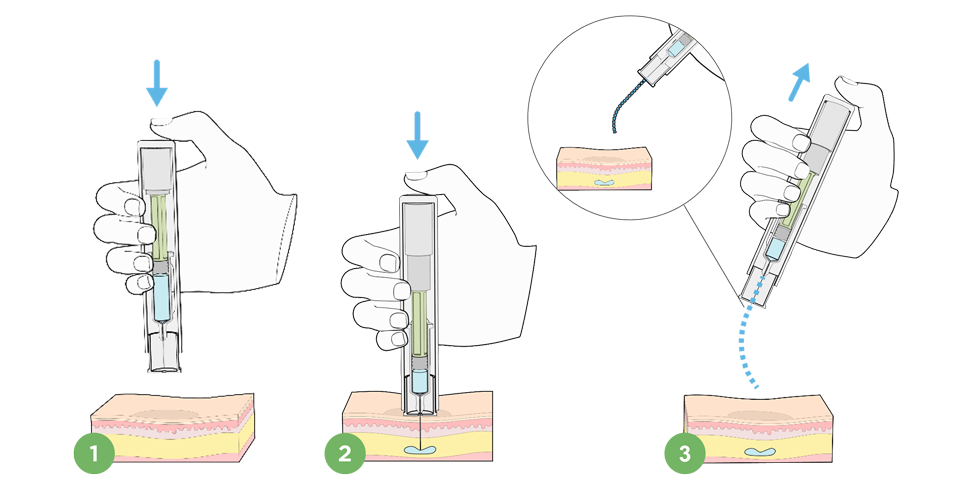
Lift and spray wet injection
This is probably what most users imagine when they hear the term "wet injection." This refers to the spray of medication following the early removal of the device from the injection site. It can occur in pre-filled syringes, autoinjectors, or pen injectors.
Type 2: Pooling from Early Release
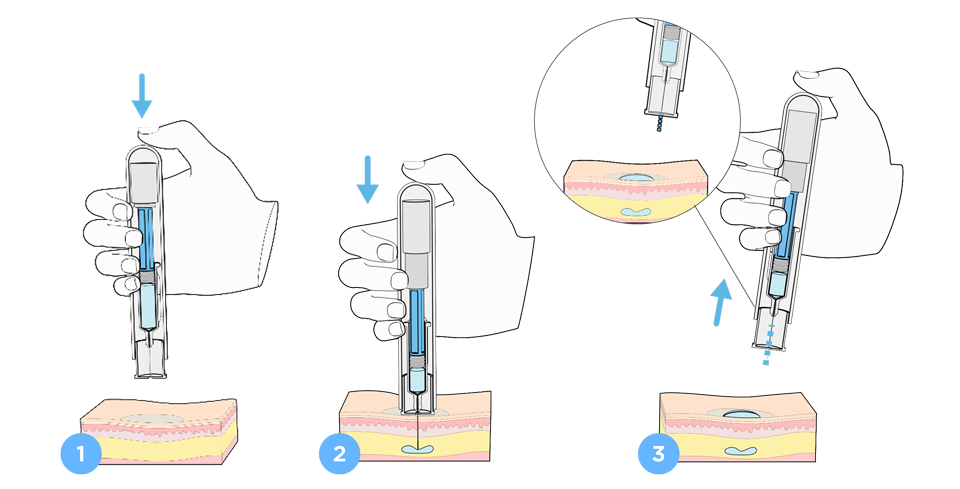
Early release wet injection
This is closely related to lift and spray and occurs when a user lifts the device early but does not completely remove it from the injection site. The medication can be dispensed either before or after needle insertion due to either early activation or early needle removal. It is most seen in horizontal injection surfaces, like a thigh, versus vertical injection surfaces, like an arm. Again, this type of wet injection can be seen in all devices.
Type 3: Pooling Due to Compression
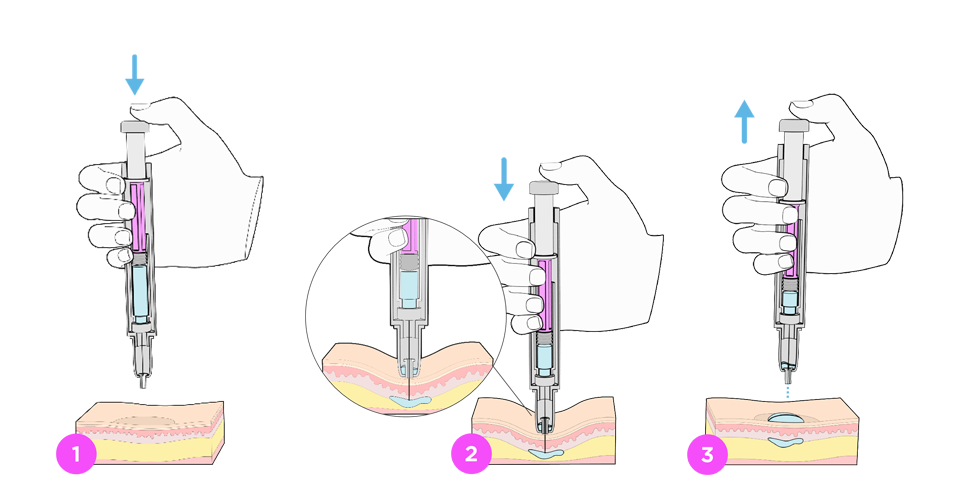
Compression-related wet injection
This is a new type of wet injection that we observed for the first time just this year. A client discovered it during bioequivalence testing and brought it to Battelle’s attention. It was observed when users pressed too hard at the injection site, trying not to move the device and inadvertently triggered the needle safety device. When the device is lifted, the medication leaks out of the injection site.
This was most often seen in muscular users with very low body fat. Our human factors experts could reproduce this type of wet injection in our labs using a denser injection pad. We observed this in a pen using a needle safety device (NSD).
Type 4: Medication Collected in a Needle Safety Device

Needle safety device wet injection
This type of wet injection was observed with pen injectors having a needle safety device (NDS). In this situation, a user would press the pen onto the injection site moving it just enough to activate the NSD before the needle reached the skin. The result was medication pooling in the NSD reservoir or the skin's surface and not entering the injection site.
Why Wet Injections Need to Be Addressed
Addressing the issue of wet injections is crucial for human factors researchers, device manufacturers, and users alike.
Researchers
For researchers, understanding the nuances of wet injections can help engineers design more effective, safer, and more user-friendly devices.
Manufacturers
For manufacturers, reducing the incidence of wet injections can lead to increased user satisfaction, improved therapeutic outcomes, and fewer product recalls.
Users
Finally, for users, avoiding wet injections can reduce anxiety and dissatisfaction, leading to better adherence to medication regimens.
Preventing Wet Injections
Mitigating wet injections involves a multi-pronged approach. The FDA's preferred hierarchy for risk mitigation provides a valuable framework.
- Ideally, the goal is to design a device that has no risks.
- Protective measures such as adding a needle safety device can be employed if a risk-free device isn't possible.
- If neither of these strategies is feasible, safety information can be conveyed via product labeling, instructions for use, packaging, or training.
- However, it's important to note that each strategy has limitations and challenges.
Improvements have been made in device design and mitigation strategies. Newer drug delivery designs have addressed many issues through visual and/or audible feedback, but there is still room for improvement. There are often limited options for tailoring or altering the device or adding protective measures, as these measures can impact safety and efficacy resulting in the need for retesting.
Understanding and addressing wet injections is crucial in the field of medical devices. While the issue presents significant challenges, it also provides opportunities for innovation and improvement.
By understanding the causes of wet injections and employing effective mitigation strategies, we can design safer, more user-friendly, and more effective devices. This benefits the users of these devices and contributes to the advancement of medical technology.
The Battelle Advantage
Wet injections are a complex challenge that requires a deep understanding of the user and the technology. At Battelle, our Human-Centric Design team provides a multidisciplinary approach combining engineering, ergonomics, and user experience expertise.
We are committed to designing devices that meet technical requirements and address end-user needs and requirements. We create solutions that enhance patient compliance and overall healthcare outcomes by prioritizing user comfort and ease of use.
Featured Expert

Jessica Sanford, Ph.D.
Senior Human Factors Engineer
Jessica Sanford joined Battelle 26 years ago and currently serves on the Battelle Medical Devices team as a Senior Human Factors Engineer. Jessica has been working in the field of human factors research for 33 years, and spent the last 12 years applying her knowledge to medical device research and development. Currently, she focuses on using research and design to help medical device customers tackle unique problems and challenges. Jessica holds a PhD in Quantitative Psychology from The Ohio State University.
Related Blogs
BATTELLE UPDATES
Receive updates from Battelle for an all-access pass to the incredible work of Battelle researchers.
